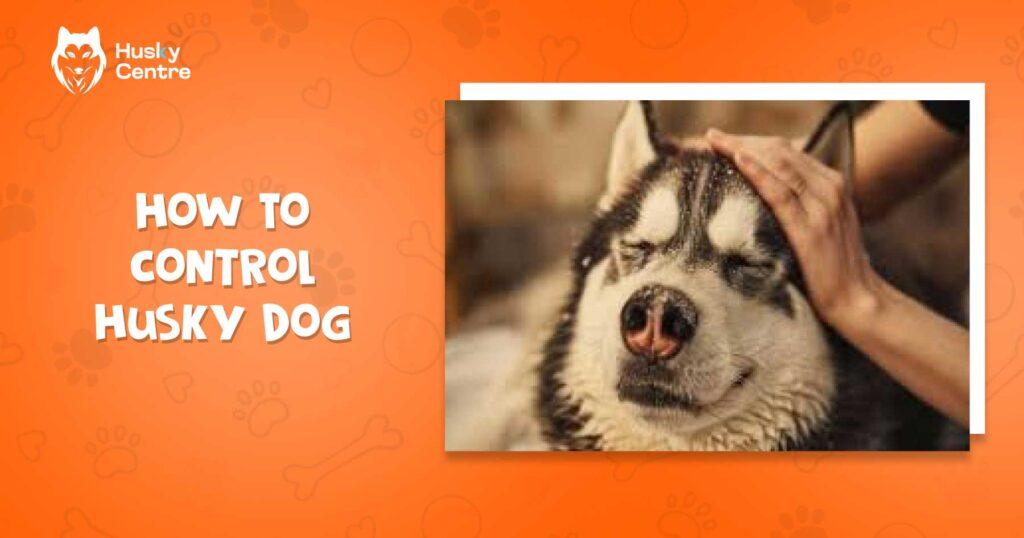To control a Husky dog, use consistent training and provide plenty of exercise. Establish clear boundaries and routines.
Huskies are energetic and intelligent dogs that require firm but loving guidance. Consistent training helps them understand expectations and boundaries. Daily exercise is crucial for managing their high energy levels and preventing destructive behavior. Socialization from a young age makes them well-adjusted and friendly.
Positive reinforcement techniques, such as treats and praise, encourage good behavior. Mental stimulation, like puzzle toys or training games, keeps their minds active. Being patient and persistent is key to effectively controlling a Husky dog. Regular check-ups with a vet ensure they remain healthy and happy. By following these steps, you can enjoy a well-behaved and loving Husky companion.
Basic Training Techniques
Husky dogs are known for their intelligence, energy, and strong-willed nature. To control a husky dog, implementing basic training techniques is essential. These techniques will help you ensure your husky is well-behaved and responsive. In this section, we’ll explore three fundamental training methods: using positive reinforcement, focusing on consistency, and starting with basic commands.
Use Positive Reinforcement
Positive reinforcement is a powerful tool in husky dog training. This method involves rewarding your dog for good behavior, which encourages them to repeat the action. Rewards can include treats, praise, or playtime. Here’s how to use positive reinforcement effectively:
- Identify a reward: Choose a treat or toy that your husky loves. This will motivate them to follow your commands.
- Immediate reward: Give the reward right after the desired behavior. This helps your husky understand which action earned the reward.
- Consistency: Always reward good behavior to reinforce the connection between the action and the reward.
Positive reinforcement can be used for various behaviors, such as sitting, staying, or coming when called. Over time, your husky will learn to associate good behavior with positive outcomes, making controlling a husky much easier.
Focus On Consistency
Consistency is crucial in training a husky. Dogs thrive on routine and clear expectations. To maintain consistency, follow these steps:
- Set clear rules: Decide which behaviors are acceptable and which are not. Communicate these rules to everyone in the household.
- Use the same commands: Always use the same words for each command. For example, use “sit” for sitting and avoid using variations like “sit down.”
- Routine training sessions: Hold training sessions at the same time each day. This helps your husky anticipate and prepare for training.
Consistency in commands and training sessions will help your husky learn faster and retain the lessons better. It also reduces confusion, making controlling a husky more straightforward.
Start With Basic Commands
Begin husky dog training with basic commands. These foundational commands are essential for safety and control. Start with the following commands:
| Command | Description |
|---|---|
| Sit | Teach your husky to sit on command. This is useful for calming them down. |
| Stay | Teach your husky to stay in place. This is crucial for safety in various situations. |
| Come | Teach your husky to come to you. This helps with recall and keeps them close. |
Use positive reinforcement and consistency to teach these commands. Practice regularly and ensure your husky understands each command before moving to the next. Mastering these basic commands will make controlling a husky much easier and set the foundation for more advanced training.
Exercise To Manage Energy
Huskies are energetic dogs that need a lot of physical activity to stay happy and healthy. Exercise to manage energy is key for controlling husky energy. Without enough exercise, huskies can become bored and destructive. Let’s explore some effective ways to manage their energy levels.
Daily Walks
Daily walks are essential for husky exercise needs. Walking helps to burn off their energy and keeps them fit. Aim for at least two walks a day, each lasting 30 to 60 minutes. This routine helps in managing husky energy effectively.
During the walks, vary the route to keep your husky interested. Different sights and smells provide mental stimulation. Here’s a simple schedule:
| Time | Duration | Activity |
|---|---|---|
| Morning | 30-45 minutes | Walk around the neighborhood |
| Evening | 45-60 minutes | Walk in the park |
Use a sturdy leash and harness for safety. Physical activity for huskies during walks helps to channel their energy and reduces the risk of behavioral issues. Consistent walking schedules keep your husky calm and content.
Playtime Sessions
Playtime sessions are another great way to meet husky exercise needs. Playing fetch, tug-of-war, or chase games can be very effective. These activities not only provide physical exercise but also strengthen the bond between you and your husky.
Consider these playtime ideas:
- Fetch: Use a ball or frisbee. Throw it far to make your husky run.
- Tug-of-War: Use a strong rope toy. Let your husky pull and tug.
- Chase Games: Run with your husky. Let them chase you around the yard.
Each playtime session should last 20-30 minutes. Rotate different games to keep your husky engaged. Playtime helps in controlling husky energy and ensures they get enough physical activity.
Mental Stimulation
Mental stimulation is as important as physical exercise for huskies. Engaging their minds prevents boredom and keeps them sharp. Interactive toys, puzzle feeders, and training exercises are great options.
Some ideas for mental stimulation:
- Puzzle Feeders: Hide treats inside. Let your husky figure out how to get them.
- Interactive Toys: Toys that move or make noise keep your husky entertained.
- Training Sessions: Teach new tricks or commands. Use positive reinforcement.
Each activity should last 15-20 minutes. Mental exercises help in managing husky energy and prevent destructive behavior. Combining physical and mental activities ensures a well-rounded routine for your husky.
Behavioral Training
Owning a Husky can be an exciting adventure. These intelligent and energetic dogs require proper behavioral training to ensure they become well-behaved companions. Here, we delve into effective strategies for husky behavior management, focusing on addressing dominance issues, using crate training, and providing clear boundaries.
Address Dominance Issues
Huskies are known for their strong-willed nature, which can sometimes lead to dominance issues. Proper training is essential to establish yourself as the leader. Here are some tips to address dominance:
- Consistency is key: Always be consistent with commands and rules. Huskies need to know what to expect.
- Positive reinforcement: Reward good behavior with treats or praise. This helps reinforce the desired actions.
- Avoid physical punishment: Physical punishment can lead to fear and aggression. Instead, use time-outs or withdraw attention to correct behavior.
In addition, socialization plays a crucial role in controlling husky behavior. Regularly expose your Husky to different environments, people, and other animals to reduce dominance-related issues. Here’s a table outlining the benefits of socialization:
| Benefit | Description |
|---|---|
| Reduced Aggression | Interaction with others helps Huskies become more friendly and less aggressive. |
| Increased Confidence | Exposure to new situations boosts your Husky’s confidence and reduces fear. |
| Improved Behavior | Well-socialized Huskies tend to display better overall behavior. |
Use Crate Training
Crate training is a highly effective method for husky behavior management. It provides your Husky with a safe space and helps with housebreaking. Here’s how to use crate training effectively:
- Introduce the crate positively: Make the crate a welcoming space by adding soft bedding and toys. Encourage your Husky to explore the crate with treats.
- Establish a routine: Consistency is crucial. Create a schedule for crate time, such as during meals, bedtime, or when you’re away.
- Gradually increase crate time: Start with short periods and gradually increase the duration. This helps your Husky get accustomed to being in the crate without anxiety.
- Avoid using the crate as punishment: The crate should be a positive space, not associated with punishment. This ensures your Husky feels safe and secure.
Crate training not only aids in housebreaking but also helps with controlling husky behavior by providing a structured environment. It teaches your Husky to relax and be calm in a confined space, which is beneficial for managing hyperactivity and anxiety.
Provide Clear Boundaries
Setting clear boundaries is essential for behavior correction in huskies. Boundaries help your Husky understand what is expected and what is off-limits. Here are some strategies to establish boundaries:
- Use verbal commands: Simple, consistent commands like “sit,” “stay,” and “no” help your Husky understand boundaries.
- Leash training: A leash helps control your Husky during walks, reinforcing boundaries and preventing pulling or wandering.
- Designate spaces: Create specific areas for eating, playing, and resting. This helps your Husky understand where certain activities are allowed.
- Reward good behavior: Praise and treat your Husky when they respect boundaries. This positive reinforcement encourages them to continue following the rules.
Clear boundaries are crucial for husky behavior management. They provide structure and predictability, which helps reduce anxiety and behavioral issues. By implementing these strategies, you can effectively manage and correct your Husky’s behavior, ensuring a harmonious relationship between you and your furry friend.
Frequently Asked Questions
How Do You Train A Husky Dog?
Training a husky requires patience, consistency, and positive reinforcement. Use treats and praise to encourage good behavior. Start with basic commands.
Are Huskies Hard To Control?
Huskies can be challenging due to their high energy and independence. Consistent training and regular exercise can help manage their behavior.
What Are The Best Training Methods For Huskies?
Positive reinforcement and consistency are key. Use treats, praise, and short, frequent training sessions to keep your husky engaged.
How Much Exercise Does A Husky Need?
Huskies need at least 1-2 hours of vigorous exercise daily. Activities like running, hiking, and fetch are ideal.
Conclusion
Mastering husky control is essential for a happy, well-behaved pet. Consistent training, exercise, and positive reinforcement are key. Remember to be patient and attentive to your husky’s needs. By following these tips, you’ll foster a strong bond and a harmonious relationship with your furry friend.


Meet Jarred, the heart and soul behind HukyCentre. With a deep affection for furry friends, he pours his passion into every word he writes. His genuine love for dogs shines through in his engaging and informative content. As a dedicated dog enthusiast, Jarred’s goal is to share valuable insights and tips that resonate with fellow dog lovers. Join Jarred on the journey as he celebrates the joy and companionship that dogs bring into our lives.



